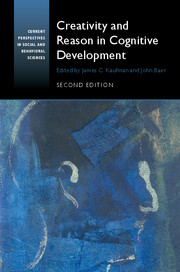Book contents
- Frontmatter
- Dedication
- Contents
- List of Contributors
- Acknowledgments
- 1 Creativity, Reason and Cognitive Development: Ten Years Later
- SECTION ONE CREATIVITY AND REASON IN CHILDHOOD AND THE SCHOOLS
- SECTION TWO CREATIVITY AND REASON IN COGNITION AND NEUROSCIENCE
- 8 The Role of Domain Knowledge in Creative Problem Solving
- 9 Processes, Strategies, and Knowledge in Creative Thought: Multiple Interacting Systems
- 10 Dynamic Processes within Associative Memory Stores: Piecing Together the Neural Basis of Creative Cognition
- 11 Creativity and Constraint: Friends, Not Foes
- 12 Creative Genius, Knowledge, and Reason: The Lives and Works of Eminent Creators
- 13 Attention, Cognitive Flexibility, and Creativity: Insights from the Brain
- SECTION THREE CREATIVITY AND REASON: INTERACTIONS AND RELATED CONSTRUCTS
- Author Index
- Subject Index
- References
13 - Attention, Cognitive Flexibility, and Creativity: Insights from the Brain
from SECTION TWO - CREATIVITY AND REASON IN COGNITION AND NEUROSCIENCE
Published online by Cambridge University Press: 05 February 2016
- Frontmatter
- Dedication
- Contents
- List of Contributors
- Acknowledgments
- 1 Creativity, Reason and Cognitive Development: Ten Years Later
- SECTION ONE CREATIVITY AND REASON IN CHILDHOOD AND THE SCHOOLS
- SECTION TWO CREATIVITY AND REASON IN COGNITION AND NEUROSCIENCE
- 8 The Role of Domain Knowledge in Creative Problem Solving
- 9 Processes, Strategies, and Knowledge in Creative Thought: Multiple Interacting Systems
- 10 Dynamic Processes within Associative Memory Stores: Piecing Together the Neural Basis of Creative Cognition
- 11 Creativity and Constraint: Friends, Not Foes
- 12 Creative Genius, Knowledge, and Reason: The Lives and Works of Eminent Creators
- 13 Attention, Cognitive Flexibility, and Creativity: Insights from the Brain
- SECTION THREE CREATIVITY AND REASON: INTERACTIONS AND RELATED CONSTRUCTS
- Author Index
- Subject Index
- References
Summary
As an emerging area of research, the neuroscience of creativity has made significant strides over the last decade by beginning to elucidate the brain bases of creative cognition (Vartanian, Bristol, & Kaufman, 2013). Among researchers and practitioners of creativity, the contributions of this new area are deemed valuable to the extent that they shed light on the key mechanisms and processes that underlie creativity. In this sense, rather than merely confirming what is already known about creativity using a new set of metrics, the true worth of neuroscientific data will involve the quality of the tools and ideas it offers for testing the “joints in the system” (Goel, 2005, p. 268; see also Shallice, 1988). In turn, as better mechanistic accounts of brain function in relation to creativity emerge, neuroscientifically informed interventions to facilitate this mode of thinking in educational, professional, and applied settings can be developed.
As noted by Goel (2005) in relation to another high-order process – reasoning – the contribution neuroscience can make to our understanding of cognition includes but also extends beyond elucidating mechanisms. Specifically, and more immediately, neuroscientific data have been a great source of knowledge regarding dissociation of cognitive functions. For example, Miller and Tippet (1996) administered Guilford's (1967) classic Match Problems task to patients with focal brain lesions and normal controls. Critically, two types of problems were administered to the participants: one set of problems involved straightforward match removal for solution, whereas another set of problems required “set shifting” to arrive at correct solutions. In the problem solving literature a set shift is defined as the ability to overcome the conceptual and/or perceptual constraints that define the problem space. Set shift problems are typically measured using perseverative errors in the Wisconsin Card Sorting Test (Grant & Berg, 1948), given that they demonstrate the participant's inability to revise the card sorting strategy following a rule change. Miller and Tippett (1996) reported that patients with focal right prefrontal cortex (PFC) lesions were impaired specifically on those match problems that required set shifts, but not otherwise. In addition, this selective impairment in performance on set-shift problems was especially apparent in patients with lesions to right ventral (as opposed to dorsal) PFC. Importantly, no such selective impairment on set-shift problems was observed in patients with temporal-occipital, parietal, central, or left frontal lesions.
- Type
- Chapter
- Information
- Creativity and Reason in Cognitive Development , pp. 246 - 258Publisher: Cambridge University PressPrint publication year: 2016



